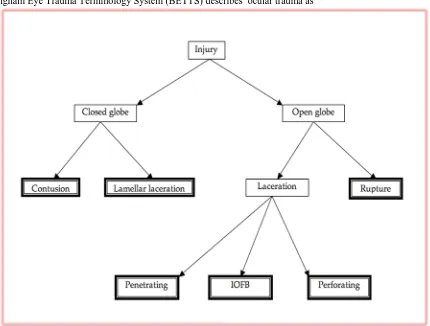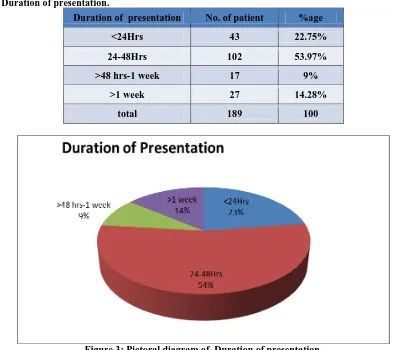CLINICO-EPIDEMIOLOGICAL PATTERN OF OCULAR INJURIES AT TERTIARY
CARE HOSPITAL IN EASTERN UTTAR PRADESH
Singh Hemendra*1, Srivastav Tanmay2, Gautam Kumar Raj3, Bhushan Prashant4, Mishra Deepak5
1Senior Resident, Regional Institute of Ophthalmology, Banaras Hindu University,Varanasi, India.
2Senior Resident, Regional Institute of Ophthalmology, Banaras Hindu University, Varanasi, India.
3Junior Resident, Regional Institute of Ophthalmology, Banaras Hindu University, Varanasi, India.
4
Associate professor, Regional Institute of Ophthalmology, Banaras Hindu University, Varanasi, India.
5Assistant Professor, Regional Institute of Ophthalmology, Banaras Hindu University, Varanasi, India.
Article Received on 24/09/2019 Article Revised on 14/10/2019 Article Accepted on 04/11/2019
INTRODUCTION
Ocular trauma is major causes of treatable visual blindness and morbidity in our population.[1] It is major disabling health problem of all groups. Approximately 1.6 million individuals are blind from ocular injuries, an additional 2.3 million individuals are bilateral low vision from this cause, and almost 19 million with unilateral blindness or low vision.[2] Patients with ocular injury need hospitalisation at the rate of 4.9 to 89 per 100000. Occurrence of ocular trauma is increased in young male individuals and the averaged in their 3rd decade of life. The characteristic female to male ratio is about 1:4 worldwide with Open globe injury being the commonest.[3-5] In United States every year there 2.5 million ocular injuries reported and out of whom about 500,000 blinding eye trauma occur anually worldwide, making important cause of one-sided blindness today and set to be next important reason for blind eyes. The occurrence of ocular trauma is even higher in developing countries.[6-8] This study will help in measuring the
burden of the visual loss and identify the responsible factors of ocular trauma. Visual outcome from ocular trauma can vary from full recovery to blind.
MATERIAL AND METHOD
The study was done at a tertiary care center in eastern part of uttar pradesh. All individual with ocular injury reported to the hospital and associated Trauma Center between February 2019 to April 2019 were inrolled in the study and studied for epidemiological and clinical factors like age and sex distribution, visual status at the time of appearance, manner of injury, final visual outcome.
Details history was taken with importance on manner of injury, duration of injury, visual acuity and condition of other eye.
Rational terminology for ocular injury and visual status were considered according to Birmingham Eye Trauma
ISSN 2455-3301
WJPMR
AND MEDICAL RESEARCH
www.wjpmr.com
*Corresponding Author: SinghHemendra
Senior Resident, Regional Institute of Ophthalmology, Banaras Hindu University,Varanasi, India.
ABSTRACT
Introduction: Ocular injuries is important major public health issue. In United States numbers are exceeding 2.5 million ocular injuries per year and out of them about 50,000 lose part or all of their vision on permanent basis and in developing countries this occurrence is even higher. The incidence at which patients with ocular injury need hospitalization range from 4.9 to 89 per 100,000. This study was conducted to find out the epidemiological prototypes of ocular injuries and various parameters influencing it. Methods: A retrospective study was carried out at tertiary care hospital between February 2019 to April 2019 and all the individual presented with ocular injuries in eye Outpatient department, Emergency Department and Trauma center were inrolled for the study. Various epidemiological and clinical factors like age, sex division, time of presentation, means of injury, category
of trauma and final visual status were analysed. Results: Out of total 189 of individuals, 141(74.6%) were below
the age of 30 years and female to male ratio was 1:2.9 About 43(22.8%) of the patients reported to hospital within 24hrs of trauma. The causes of ocular trauma included Road traffic accidents 76 cases (40.2%), sports related and recreational 47(24.5%), occupation related 39(20.6%), domestic violence 10(5.3%) and physical assault related 17(9%). Among the type of injuries Open globe injuries responsible for cases 159(84.1%) and patients 30(15.9%) affected by closed globe injuries. The main responsible factor for poor visual outcome was delayed presentation to hospital.
Terminology System (BETTS) and World Health Organization (WHO).
Distance vision impairment:
Mild – visual acuity worse than 6/12
Moderate – visual acuity worse than 6/18
Severe – visual acuity worse than 6/60
Blindness – visual acuity worse than 3/60.
Birmingham Eye Trauma Terminology System (BETTS) describes ocular trauma as
Figure 1: Betts: framed box used for clinical diagnosis.
Statical Tools - Data was reviewed using appropriate statistical tests (SPSS v16.0) and outcome was reviewed with previous studies for discussion. Association among variables was checked by Chi-Square test and significance was considered when p<0.05.
RESULTS
• Our study screened 203 (14 patients lost follow up)
patients of ocular trauma attending eye OPD,
Emergency Department and Trauma Center out of them 189 were included in the time period from February 2019 to April 2019.
• Out of total no. of patients, 141(74.6%) were below
the age of 30 years. There are female to male ratio was 1:2.9 (Table 1).
Table 1: Age group and sex division of patients with ocular injury.
Age Male Female Total
0-10 years 63 19 82
11-20 yrs 32 10 42
21-30 yrs 13 4 17
31-40 yrs 5 2 7
41-50 yrs 13 3 16
51-60 yrs 15 4 19
> 60 yrs 5 1 6
Figure 2: Bar diagram of age and sex distribution.
• In this study, 43(22.8%) of the patients presented to hospital within 24hrs of trauma while 145(76.7%) attended
hospital within 2 days and 17 (9%) in 2 to 7 days after trauma.(Table 2)
Table 2: Duration of presentation.
Duration of presentation No. of patient %age
<24Hrs 43 22.75%
24-48Hrs 102 53.97%
>48 hrs-1 week 17 9%
>1 week 27 14.28%
total 189 100
Figure 3: Pictoral diagram of Duration of presentation.
Road traffic accidents are the most important reason of ocular trauma and accounts for cases (43.3%) in our study. Other causes included sports related and recreational (5%), occupation related (6.7%), fall from
Table 3: Mode of injury and sex distribution of patient with ocular trauma.
Mode of injury male female Total (%age)
Road traffic accident 62 14 76 (40.2)
Sport related 44 3 47 (24.5)
Occupational related 22 17 39(20.6)
Physical assault 12 5 17 ( 9)
Domestic violence 3 7 10 (5.3 )
total 143 (75.6%) 46(24.3%) 189 (100%)
In our study, cases 67 (35.4%) were blind at presentation i.e., visual acuity <3/60, majority of final visual outcome was
<6/18-3/60 i.e 78(41.3%) and 44(23.3%) with visual acuity 6/6-6/18.(Table 4)
Table 4: Type of injury and final visual outcome at 6 week. Globe Injury
(Close and open globe)
<3/60-PL
Negative <6/18-3/60 6/18-6/6 Total (%age)
Lamellar laceration 6 0 3 9 (4.8%)
contusion 11 8 2 21(11.1%)
perforating 17 14 13 44(23.3%)
penetrating 23 36 16 75(39.7%)
Intraocular foreign
body 4 7 3 14 (7.4%)
adnexal 6 13 7 26(13.8%)
Total 67 (35.4%) 78(41.3%) 44(23.3%) 189 (100%)
DISCUSSION
The burden of ocular trauma was found to be 1.2% out of total individuals attending Eye Opd, Emergency and Trauma center. This number is significantly lower when compared to other studies. JUDO reported at south west Ethiopia, where this burden was found 6.9%, with 63.8% of the cases below the age of 30 years with mean age 25.5 years and male to female ratio 3.2:1. There were 141(74.6%) cases belongs 30 years of age and male to female ratio was 2.9:1 in our study. JUDO study revealed that 31.6 % of cases reported within 48 hours while 28.6% arrived one week or later.[9] In our study, 43(22.8%) of the patients reported to hospital within first 24 hrs of trauma while 145(76.7%) attended hospital within 2 days and 17 (9%) in 2 to 7 days after ocular trauma. In Haryana study found that males (76.01%) are affected more commonly than females (23.99%). Our study was showed male female ratio in this same approach. Cornea was the commonest structure affected
in about 47.6% followed by iris in 32.64%.[10]
Mukherjee et al. study reported 44.9% of patients were fall within the 20 yrs of age, emphasizing the vulnerability of younger age.[11] In our study this number were 65.6%. Shukla IM et al reported 29.5 % of the patients were under 30yrs of age.[12] In our study this number were reduced to 9%. Similarly 86.74% of patients came from first 30yrs of life reported by Parmar et al in 1985. In our study 74.6% patients came under this category.
Shukla IM et al showed : Ocular trauma shows 31.50% patients reported in first 24 hrs, 48% of patients reported within 1st week and 20.5% reported after the 1st week.[12] Our study showed that 22.8% of patients first contact
with the Ophthalmologist within 24 hrs &85.7 % turned
up to RIO, BHU hospital within first week. The majority of patients belongs to rural area of Eastern part of uttar pradesh & most of them are not conscious about risk problem of ocular injuries. The better visual outcome at the end of six week depends on earliest visit to ophthalmologist.
SUMMARY AND CONCLUSION
From this study it is concluded that delay in 1st visit has a significant effect on final visual status along with presence of complications. This study showed road traffic accidents were most important reason of ocular injuries followed by sport related injuries, occupation related injuries and physical assult. So preventive and precautionary measures are advised like wearing helmet and seat belts while driving, protective goggles during welding, supervising children while playing to prevent ocular injuries. An urgent referral system for ocular trauma patients. In our study, cases 67 (35.4%) were blind at 6 week follow up i.e., visual acuity <3/60, majority of final visual outcome was <6/18-3/60 i.e 78(41.3%) and 44(23.3%) with visual acuity 6/6-6/18.
Declaration of patient consent
The authors certify that they have obtained all appropriate patient consent forms. In the consent form the patient has given his consent for his/her clinical information to be reported in the journal.
Financial support Nil.
Conflicts of interest
There are no conflicts of interest.
REFERENCES
1. Omolase CO, Omolade EO, Ogunleye OT, Omolase
BO, Jhemedu CO, Adeosun OA. Pattern of ocular
injuries in Owo, Nigeria. J. Ophthalmic Vis Res
2011; 6: 114-118.
2. Negrel AD, Thylefors B. The global impact of eye
injuries. Ophthalmic Epidemiology 1998; 5:
143-169.
3. Khan MD, Mohammad S, Islam ZU, Khattak MN.
An 11 years review of ocular trauma in the North
West Frontier Province of Pakistan. Pak J
Ophthalmology, 1991; 7: 15-18.
4. Kuhn F. Epidemiology of ocular trauma. In: Kuhn F,
Morris R, Mester V, Witherspoon D. Ocular Traumatology. Springer- Verlag Berlin Heidelberg. 2005: 47-77.
5. Framme C, Roider J. Epidemiology of open globe
injuries. Klin Monatsbl Augenheik 1999; 215:
287-293.
6. Nordberg E. Injuries as a public health problem in sub-Saharan Africa: Epidemiology and prospects for control. East Afr Med J 2000; 77: 41–43.
7. Mieler W (2001) Overview of ocular trauma. In
Principles and Practice of Ophthalmology 2nd edition. In Albert D, Jakobiec F, editors. Philadelphia, WB Saunders Co, p 5179.
8. Vats S, Murthy GVS, Chandra M, Gupta SK,
Vashist P Epidemiological study of ocular trauma in an urban slum population in Delhi, India. Indian J Ophthalmol 56: 313–316.
9. Asaminew T, Gelaw Y, Alemseged F. A 2-year
review of ocular trauma in JIMMA University
Specialized Hospital. Ethiop J Health Sciences
2009; 19: 67-76.
10 Mela EK, Dvorak GJ, Mantzouranis GA, Giakoumis
AP, Blatsios G, et al. Ocular trauma in a Greek population: review of 899 cases resulting in
hospitalization. Ophthalmic Epidemiol 2005; 12:
185–190.
11 AK,Saini JS,Dabral SM. A profile of penetrating eye
injury. Indian J Ophthalmol Sept. 1984; 32: 269-271.
12 Shukla IM, Verma RN. A clinical study of ocular
injuries. Indian J. Ophthalmol 1979; I: 33-36.
13 Parihar JK1, Dash RG, Vats DP, Verma SC, Sahoo
PK, Rodrigues FE. Indian J Ophthalmol. 2000 Sep; 48(3): 227-30.
14 Badrinath SS. Ocular Trauma. Indian J. Ophthalmol


